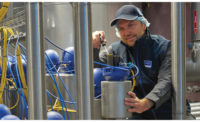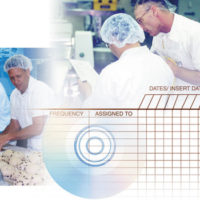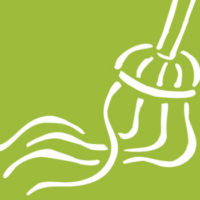Sanitation is playing a bigger role in food processing than ever before. Whether it is used to minimize spoilage to extend shelf life or to maximize food safety, an effective sanitation program is key to controlling food safety issues such as Listeria monocytogenes and Salmonella, and maintaining product shelf life. The decision on how a food plant will go about updating its facility, equipment and/or processes to maximize sanitation depends on several factors, such as the following:
• The challenges the company currently faces, including the complexity of the process, equipment design and types of soils involved;
• Whether there have been microbial issues that are triggering the need for a renovation such as a major spoilage incident, recall or outbreak of foodborne illness associated with the company’s product or a like product or process;
• The results of any root-cause analysis performed;
• The current condition, from a sanitation and sanitary design perspective, of the Good Manufacturing Practices (GMPs), facility and equipment;
• How much of the process or facility requires updating; and
• How much money the company has to spend on retrofitting or updating its GMPs, facilities and/or equipment.
Whether the retrofit is major or minor, there are multiple best practices and hurdles that can be applied to maximize sanitation in a food processing facility that address GMPs, sanitary design of equipment and facilities, and effective cleaning and sanitation. The success of any sanitation program, whether you are just starting or retrofitting an existing program, begins and ends with the food safety culture of the company and of the plant. As the late, great Don Graham used to say, the proper mindset is key to achieving food safety.
GMPs
One of the first items to be addressed is the flow of the process and complete separation of raw and ready-to-eat (RTE)/finished product areas. Too many food production facilities either were not initially designed to flow from incoming receiving of raw materials straight through to shipping or have been retrofitted to accommodate increased production needs. The result is often an RTE production room or area surrounded by raw areas, or traffic (including employees) and supplies having to travel through an RTE or finished product area to go to and from locker rooms, break rooms and so on. Consider for your facility and processes where the line of separation between the areas for raw and finished product is in your facility and where your product goes from being a raw agricultural commodity to a finished product that will be consumed by the end-user without a microbial control/reduction or kill step.
Some simple changes may have a major impact on food safety, such as a complete separation of raw and RTE/finished product areas including, when possible, separate break/locker rooms for employees; separate maintenance shops, tools and carts; captive footwear; chemical food dips/baths or floor foamers, especially in high-traffic areas, at entrances to RTE and at exits from raw areas; elimination of floor mats as they are not easily or effectively cleaned; and replacement of leather/canvas/nylon tool bags and belts as they are not cleanable.
Review written Standard Operating Procedures (SOPs) and observe the implementation of SOPs on the floor: Are you doing what you say you are doing? Are the SOPs and GMPs effective in achieving the desired result, such as controlling traffic or minimizing cross-contamination during product handling? When reviewing employee SOPs/GMPs, consider the following: handwashing, sanitizing and glove use, and whether employees are performing multiple tasks. While multitasking may seem efficient from a production standpoint, it can be very risky if food handlers (supervisors and leads) are also handling nonproduct contact surfaces and items such as pallets, pallet jacks, trash, boxes, etc. and returning to handling product contact areas without sanitizing or changing gloves. Adequate personal protective equipment (PPE; gloves, sleeves, aprons, etc.), handwashing facilities and sanitizer should be accessible and readily available, not located in a corner of the room or across the plant where they are not likely to be used. Look for opportunities to separate and designate employees through color-coding by task and risk. Differently colored hairnets, bump caps, gloves, frocks, aprons, etc. can be used to distinguish employees who handle direct product and product contact surfaces from employees who handle boxes, pallet jacks, trash, etc.
Review and verify your food safety education and training program for all employees, including permanent, part-time and seasonal employees, management, supervisors and maintenance. Review and observe any off-site training for temporary employees. If you do not have an education and training program, develop one. There are also some third-party education and communication services that can be tailored to meet your needs; however, as with any program, it is up to the facility to follow up and verify that the training is effective when implemented on-line, that it achieves the desired results and that there is refresher training and training for new employees.
Hygienic Design of Equipment and Facilities
Equipment
Hygienic design, when applied from the very first steps of the design process, is very good for both engineering and food safety. Hygienic features, such as the removal of cracks and crevices to eliminate microbiological contamination, can also reduce engineering problems, such as stress and crevice corrosion. The North American Meat Institute previously published 10 Principles of Sanitary Equipment Design (Table 1[1]) and 11 Principles for Sanitary Facility Design (Table 2[2]) that are available online along with online checklists. These principles have also been adapted for use in low-moisture facilities and for produce.
When evaluating equipment from a sanitary-design perspective, consider that higher-risk food contact surfaces must be nonreactive, noncorrosive, noncontaminating and cleanable. There should not be any hidden areas within the equipment that will accumulate product or soil and allow microorganisms to grow. Cleanability is particularly important for older equipment and for equipment for which a newer, more hygienic design is not available. The equipment must be able to be taken apart, cleaned/scrubbed (including parts), sanitized and reassembled without the need for special tools, equipment or skills. The ease of disassembly of equipment for sanitation purposes as well as ease of disassembly for maintenance personnel facilitates access and reduces downtime.
Just about any design can be retrofitted to eliminate hygienic hazards; however, this often involves time and money, and the final cost of retrofitting is generally significantly higher than the purchase of new, hygienically designed equipment. While there is no downside to having more hygienically designed equipment, the cost (capital investment) is often a deal breaker for many processors, especially for a smaller operation. Although hygienically designed equipment may be pricier due to the cost of materials such as stainless steel and the design, the long-term benefits more than pay for the initial capital investment through reduced maintenance costs, often longer life of the equipment and lower costs associated with cleaning, including labor (both sanitation and maintenance), water and chemical usage, and food safety. When a facility is considering retrofitting, redesigning or replacing existing equipment, consider addressing your highest-risk pieces of equipment first. That includes equipment and materials that are used in direct contact or close contact with finished product, including fillers, blenders, mixers, baggers, peelers, slicers/dicers/portioners, enrobers, conveyors and conveyance equipment such as augers, scales, cappers, packaging equipment, etc.
What can you do today? Install tension-release mechanisms on belts and conveyors to allow for greater access for hand scrubbing, detailed cleaning, sanitizing and inspection. Replace worn, torn and cracked belting with polyurethane belting that has a smooth surface, inert composition and is easier to clean. Remove and replace rubber wheels on carts, stands and equipment with the newer plastic wheels that are stronger and more resistant to degradation by cleaning chemicals. Eliminate equipment identification/asset tags that are riveted, screwed or otherwise attached in a manner that allows food debris to become trapped behind the tag but are not accessible for routine cleaning and sanitizing. Eliminate soft metals, wood/medium-density fiberboard composite, foam bumpers and guards, canvas/fabric/nylon parts and belts, hollow rollers and open gasket materials. Closed-cell materials do not tend to trap moisture or food soils and are easier to clean. Eliminate (redesign or replace) niche areas that may trap water, food debris and microorganisms, such as hollow frames on equipment, hollow rollers, overlapping surfaces, metal-to-metal or Delrin-to-metal sandwich areas and acute angles and corners. Replace temporary quick fixes such as floor patches, plastic on ceilings, cording/string, tape, etc. with more permanent solutions. Replace plastic barrels with stainless steel trash holders that are a more cleanable alternative to and may eliminate the need for plastic barrels and dollies for trash, rework and recyclables. Consider using plastic pallets or other cleanable materials in RTE areas, as wood tends to absorb water. Keep in mind that plastic pallets can also become damaged, so manage and monitor them to remove damaged pallets before this becomes an issue. Eliminate tack welds and spot welds on equipment. All welding should be continuous, completely finished and polished to food-grade standards to eliminate niches and allow easy and effective cleaning. For wall-mounted equipment, there should be adequate space around and between equipment and walls to allow for sufficient cleaning. If this is not possible, make sure the equipment is completely sealed to the wall. Replace uncleanable uni-strut metal framing and utility brackets, as they have niches that are inaccessible for thorough cleaning and sanitizing. Install the newer roll-up doors that can be set just above the floor elevation, thereby preventing the bottom surfaces of the door seals from contacting the floor and reducing the risk of contamination from the floor being aerosolized as the door is raised and lowered.
Facilities
If this is a major renovation, building from the ground up is preferred in some instances, because the facility and utilities can all be customized to maximize sanitary standards. On the other hand, retrofitting an existing structure, again depending on how much renovation is required, may be more cost effective and may allow the company to be up and running sooner; however, the company will need to design around the current footprint. Sanitary design principles, such as those published by the North American Meat Institute,1,2 should be considered when renovating a food processing facility for optimal performance and cleanability.
When reviewing the facility, consider that one of the most used and abused surfaces in a processing facility is the flooring. Floors are exposed to heavy and constant traffic from equipment, water, cleaning and sanitizing chemicals, as well as changes in temperature. When renovating a facility, money spent on the best available flooring will reduce issues that tend to occur with less expensive flooring materials and those issues that can and do occur over time, such as cracks, holes and damage, as these problems are uncleanable and can harbor microorganisms. Patching these areas often creates more issues than it tends to solve. Eliminate the use of flooring with expansion joints that can trap water and food debris and become areas for microbial harborage. Floors need to be pitched to the drain, and away from equipment and walls, to allow for effective drying and to facilitate the elimination of pooling and standing water.
Walls are often taken for granted when it comes to design. They should be of a cleanable, nonabsorbent material such as metal, fiber-reinforced plastic, tile or concrete. Eliminate unnecessary wall-mounted structures that compromise wall material and expose areas such as insulation behind the wall to food debris, water and microbial harborage. Coving the wall-floor juncture will protect wall joints, which tend to become collection points for dirt, food debris and water, and are uncleanable and may compromise the interior of the wall. Ceilings and overhead structures including cooling units, utilities and catwalks are often overlooked and undercleaned. During a renovation, consider using a solid walk-on type of ceiling where piping and utilities are located outside of exposed production areas. This allows for utilities (water, electric, etc.) to be serviced without compromising the production area and equipment. The ceiling located in the main production areas can then be cleaned easily without interference from overhead structures such as piping. The control of the air quality flow and positive air pressure has become a major factor in designing and operating a food processing facility. Newer air-handling systems are available that filter and condition air in the processing rooms with virtually no condensation and, along with effective GMPs, tend to reduce contamination by dust and microbes. Leaking water lines, pipes, hoses and air lines should be addressed and eliminated.
Sanitation
All too often, not enough attention is paid to the sanitation process, and retrofitting sanitation to address a food safety or spoilage issue may be as simple as reviewing the sanitation process and verifying that sanitation is being performed effectively. Whether you have an in-house sanitation crew or hire a third-party contract cleaning company, the sanitation process should be given your full attention. Pushing production later and later, resulting in a shortened cleaning window, is not a win-win situation for anyone, and steps in the cleaning process, such as scrubbing, will be skipped, and some pieces of equipment may not receive necessary attention during cleaning.
Review your sanitation process to ensure that employees have the following: adequate time to clean and access to equipment; proper training on handling chemicals and on the cleaning and sanitation process, including scrubbing; the correct tools to effectively and safely clean, including adequate and appropriate PPE, chemicals, scrub pads, buckets, brushes, hoses and foamers for wet (and controlled wet) cleaning; an adequate amount of hot water for the entire sanitation shift; access to maintenance for equipment disassembly and reassembly; proper supervision and support; a master sanitation schedule; knowledge of how to perform deep cleaning on a scheduled frequency; proper SOPs and tools to effectively clean drains; and proper management/control of water such as the use of water containment berms/barriers, especially for dry processes.
The principle of “less is more” is important for sanitation GMPs in food processing rooms. Items such as ladders, hoses and pallet jacks should be designated and left in the room; however, limit the storage of items not cleaned during sanitation such as labels, PPE, paper towels and so on inside processing rooms. This allows for everything in the room to be cleaned every night. Items can be brought into the room at start-up in cleaned and sanitized plastic tubs. Eliminate the use of high pressure in RTE areas for the final rinse of equipment and for any recleaning of areas and equipment during the preoperation inspection. It is also important to consider the cleaning and sanitation as well as the design of cleaning tools such as foamers, hoses, nozzles, squeegees, shovels and brushes so that the cleaning equipment does not become a major source or vector for contamination. One-piece, single-blade squeegees are preferred from a design standpoint to squeegees with wooden handles and screwed-on heads or squeegees with open-cell, foam-type heads that are not cleanable and tear easily. Newer hygienic designs in brushware facilitate ease of cleaning while minimizing areas for microbial harborage.
Producing and selling safe food is the right thing to do. It is good for business and consumers and to protect the public health. Upgrading your plant’s sanitation procedures and materials is a key step in bringing your facility up to the highest standards of food safety.
Margaret D. Hardin, Ph.D., is vice president of technical services at IEH Laboratories & Consulting Group. Previously, Margaret held positions at Texas A&M University, Boar’s Head, Smithfield Packing Co. and Sara Lee Foods. She currently works closely with the food industry in food safety and food microbiology-related areas. She is a member of the Editorial Advisory Board of Food Safety Magazine.
References
1. Adapted from www.meatinstitute.org/index.php?ht=a/GetDocumentAction/i/11006.
2. Adapted from www.meatinstitute.org/FoodSecurity/11PrinciplesHandout.ppt.




